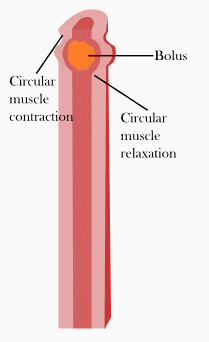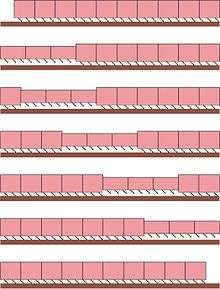Peristalsis
Peristalsis is a radially symmetrical contraction and relaxation of muscles that propagates in a wave down a tube, in an anterograde direction.

In much of a digestive tract such as the human gastrointestinal tract, smooth muscle tissue contracts in sequence to produce a peristaltic wave, which propels a ball of food (called a bolus before being transformed into chyme in the stomach) along the tract. Peristaltic movement comprises relaxation of circular smooth muscles, then their contraction behind the chewed material to keep it from moving backward, then longitudinal contraction to push it forward.
Earthworms use a similar mechanism to drive their locomotion,[1] and some modern machinery imitates this design.
The word comes from New Latin and is derived from the Greek peristellein, "to wrap around," from peri-, "around" + stellein, "draw in, bring together; set in order".[2]
Human physiology
Esophagus
After food is chewed into a bolus, it is swallowed and moved through the esophagus. Smooth muscles contract behind the bolus to prevent it from being squeezed back into the mouth. Then rhythmic, unidirectional waves of contractions work to rapidly force the food into the stomach. The migrating motor complex (MMC) helps trigger peristaltic waves. This process works in one direction only and its sole esophageal function is to move food from the mouth into the stomach (the MMC also functions to clear out remaining food in the stomach to the small bowel, and remaining particles in the small bowel into the colon).[3]

In the esophagus, two types of peristalsis occur:
- First, there is a primary peristaltic wave, which occurs when the bolus enters the esophagus during swallowing. The primary peristaltic wave forces the bolus down the esophagus and into the stomach in a wave lasting about 8–9 seconds. The wave travels down to the stomach even if the bolus of food descends at a greater rate than the wave itself, and continues even if for some reason the bolus gets stuck further up the esophagus.
- In the event that the bolus gets stuck or moves slower than the primary peristaltic wave (as can happen when it is poorly lubricated), stretch receptors in the esophageal lining are stimulated and a local reflex response causes a secondary peristaltic wave around the bolus, forcing it further down the esophagus, and these secondary waves continue indefinitely until the bolus enters the stomach. The process of peristalsis is controlled by the medulla oblongata. Esophageal peristalsis is typically assessed by performing an esophageal motility study.
- A third type of peristalsis, tertiary peristalsis, is dysfunctional and involves irregular, diffuse, simultaneous contractions. These contractions are suspect in esophageal dysmotility and present on a barium swallow as a "corkscrew esophagus".[4]
During vomiting, the propulsion of food up the esophagus and out the mouth comes from contraction of the abdominal muscles; peristalsis does not reverse in the esophagus.
Small intestine
Once processed and digested by the stomach, the semifluid chyme is squeezed through the pyloric sphincter into the small intestine. Once past the stomach, a typical peristaltic wave only lasts for a few seconds, travelling at only a few centimeters per second. Its primary purpose is to mix the chyme in the intestine rather than to move it forward in the intestine. Through this process of mixing and continued digestion and absorption of nutrients, the chyme gradually works its way through the small intestine to the large intestine.[3]
In contrast to peristalsis, segmentation contractions result in that churning and mixing without pushing materials further down the digestive tract.
Large intestine
Although the large intestine has peristalsis of the type that the small intestine uses, it is not the primary propulsion. Instead, general contractions called mass movements occur one to three times per day in the large intestine, propelling the chyme (now feces) toward the rectum. Mass movements often tend to be triggered by meals, as the presence of chyme in the stomach and duodenum prompts them (gastrocolic reflex).
Lymph
The human lymphatic system has no central pump. Instead, lymph circulates through peristalsis in the lymph capillaries, as well as valves in the capillaries, compression during contraction of adjacent skeletal muscle, and arterial pulsation.
Sperm
During ejaculation, the smooth muscle in the walls of the vas deferens contracts reflexively in peristalsis, propelling sperm from the testicles to the urethra.[5]
Earthworms

The earthworm is a limbless annelid worm with a hydrostatic skeleton that moves by peristalsis. Its hydrostatic skeleton consists of a fluid-filled body cavity surrounded by an extensible body wall. The worm moves by radially constricting the anterior portion of its body, resulting in an increase in length via hydrostatic pressure. This constricted region propagates posteriorly along the worm's body. As a result, each segment is extended forward, then relaxes and re-contacts the substrate, with hair-like setae preventing backwards slipping. [6] Various other invertebrates, such as caterpillars and millipedes, also move by peristalsis.
Machinery
A peristaltic pump is a positive-displacement pump in which a motor pinches advancing portions of a flexible tube to propel a fluid within the tube. The pump isolates the fluid from the machinery, which is important if the fluid is abrasive or must remain sterile.
Robots have been designed that use peristalsis to achieve locomotion, as the earthworm uses it.[7][8]
Related terms
- Catastalsis is a related intestinal muscle process.[3]
- Aperistalsis refers to a lack of propulsion. It can result from achalasia of the smooth muscle involved.
- Basal electrical rhythm is a slow wave of electrical activity that can initiate a contraction.
- Ileus is a disruption of the normal propulsive ability of the gastrointestinal tract caused by the failure of peristalsis.
- Retroperistalsis, the reverse of peristalsis
Notes and references
- "Earthworm - Muscular System".
- "Online Etymology Dictionary". etymonline.com. Retrieved 2016-06-30.
- Marieb, Elaine N. & Hoehn, Katja "Human Anatomy & Physiology" 8th Ed., Benjamin Cummings/Pearson, 2010
- Mittal, Ravinder K. (2011). Motor Patterns of the Esophagus—Aboral and Oral Transport. Morgan & Claypool Life Sciences.
- William O. Reece (21 March 2013). Functional Anatomy and Physiology of Domestic Animals. John Wiley & Sons. pp. 451–. ISBN 978-1-118-68589-1.
- Quillin KJ (May 1998). "Ontogenetic scaling of hydrostatic skeletons: geometric, static stress and dynamic stress scaling of the earthworm lumbricus terrestris". The Journal of Experimental Biology. 201 (12): 1871–83. PMID 9600869.
- Sangok Seok, C.D. Onal; et al. (2010-05-07). "Peristaltic locomotion with antagonistic actuators in soft robotics" (PDF). Massachusetts Institute of Technology. Retrieved 2014-11-20.
- Alexander Boxerbaum (2010-05-10). "A New Form of Peristaltic Locomotion in a Robot". YouTube. Retrieved 2014-11-20.
External links
- Interactive 3D display of swallow waves at menne-biomed.de
- Peristalsis at the US National Library of Medicine Medical Subject Headings (MeSH)
- Nosek, Thomas M. Essentials of Human Physiology. Section 6/6ch3/s6ch3_9
- Overview at colostate.edu